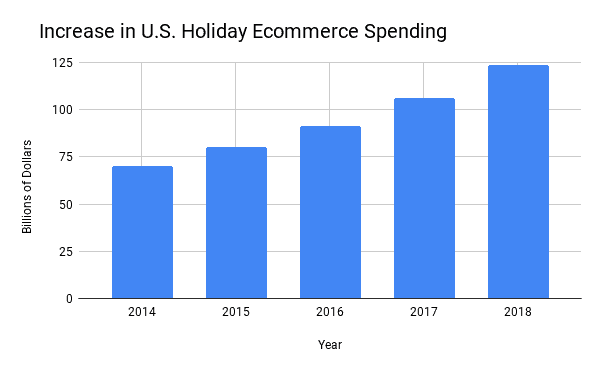The 2018 holiday shopping season gives every indication of being a record-breaker, topping $1 trillion in consumer spending in the United States for the first time ever, according to eMarketer.
The combination of low unemployment, high consumer confidence, rising wages and an extra week in the holiday shopping season has analysts at eMarketer predicting holiday sales will rise nearly 6 percent over last year. Not surprisingly, leading the charge (literally) to higher sales will be ecommerce, which eMarketer says will soar by 16.6 percent year-over-year.
“For retailers, it will be a battle for ecommerce market share,” eMarketer analyst Cindy Liu said in the firm’s holiday forecast. “We should expect more promotions and perks like free and fast shipping, as retailers compete against Amazon.”
That’s good news for hard-working people — whether they are working hard at legitimate jobs or they make their livings defrauding ecommerce businesses. No, it’s not the warm and fuzzy of the holiday season, but the truth is, fraudsters are business people. They have revenue goals and they frequently have bosses to answer to.
And there is only one way for them to get a holiday bonus — steal it.
The holiday season offers fraudsters the perfect opportunity to work overtime. The number of orders skyrocket. Retailers might be understaffed, due to increased demand and the desire of employees to have time off around the holidays. There is a certain urgency to ship orders in time to be received as holiday gifts.
Furthermore, retailers will be seeing many customers for the first time — customers who are buying gifts to be shipped to addresses with which they have no apparent association. And if they are generous shoppers, retailers might see an unusually high number of high-value orders.
All of those confusion-causing conditions are likely to be worse in 2018. Signifyd Director of Risk Consulting Tim Davis says one of the biggest differences between this holiday season and years past will be the increased buying by consumers who feel flush.
Growing ecommerce brings growing ecommerce fraud
“Another thing to think about that makes this year different is the increasing shift to ecommerce,” Davis said. “Even though spending is up, overall the spending keeps shifting more and more online. So we expect a higher portion of this year’s holiday spending will be online versus last year, versus the year before. It’s always increasing as people shift to more online.”

Source: eMarketer
In all, U.S. consumers are expected to spend $123.73 billion online this holiday season, accounting for 12.3 percent of all retail spending.
So, what can retailers do to protect themselves from fraudsters in the heat of the holiday season? We’re glad you asked. Signifyd has taken a deep look at the fraud and spending dynamics of the holiday season in its second release of “Easing the Pain of the Holiday Crush: How to Ensure that the Season of Giving Doesn’t Become the Season of Taking.”
We know you’re busy, though. And so we’ll boil down the five tips included in the holiday e-book:
- Get ready: Remember that just as the holiday season speeds up and scales up your marketing, merchandising, fulfillment and customer service, it also speeds up fraudulent orders. Gear up early to protect yourself just as you gear up for the increased orders the holidays bring.
- Trust your gut: If the order you’re reviewing were a slam-dunk, safe bet, you wouldn’t be reviewing it. Many orders come with wrinkles, but that doesn’t mean a fraudster is behind it. And the last thing you want to do is decline an order placed by a legitimate customer. (“How the Retailer Stole Christmas,” anyone?) Are you able to craft a narrative — based on all the history and data available — that explains the unusual set of circumstances that has come together in a particular order? If you are, there is a high likelihood that you’re looking at a good order.
- Don’t be hyper-focused on sticker price: Fraudsters don’t evaluate products on the price you sell them for. They focus on the price they can sell them for — quickly in the resale market. And fraudsters want to look like regular customers, not attention-grabbing high rollers. Sure, electronics and jewelry are attractive to fraudsters, but so are everyday replenishables, like diapers, baby formula and pet food. Consumers are very familiar with the regular price of everyday products and will jump on a good deal.
- Scale up vigilance: Turn to automation to handle the increased volume and velocity of the holiday season. Some retailers see as much as 30 percent of their sales during the holidays. No doubt many of those orders are placed by consumers with whom the merchant has no order history. Guaranteed Merchant Fraud Prevention platforms have seen many more consumers — both legitimate and fraudulent — than any single merchant. For instance, at Signifyd there is generally a three-in-five chance that we’ve seen your customer before in our merchant network.
- Get some help: The holiday season doesn’t have to be overwhelming. Signifyd’s machine-learning fraud-prevention system can easily supplement your existing system so you can keep up with the holiday shopping surge. Best of all, its Guaranteed Fraud Prevention provides a 100 percent financial guarantee on all approved orders that turn out to be fraudulent. That means retailers can focus on serving their customers and realizing the tremendous opportunity presented by the busiest time of the year.
>>Download the Free Holiday E-book here<<
Photo by iStock








